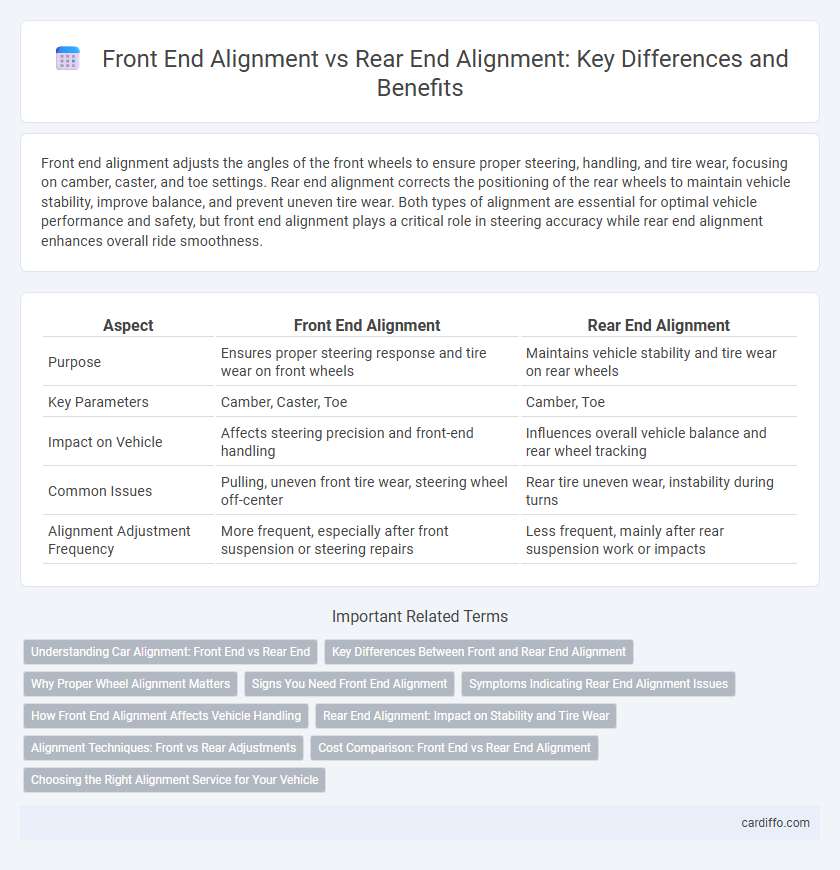Front end alignment adjusts the angles of the front wheels to ensure proper steering, handling, and tire wear, focusing on camber, caster, and toe settings. Rear end alignment corrects the positioning of the rear wheels to maintain vehicle stability, improve balance, and prevent uneven tire wear. Both types of alignment are essential for optimal vehicle performance and safety, but front end alignment plays a critical role in steering accuracy while rear end alignment enhances overall ride smoothness.
Table of Comparison
| Aspect | Front End Alignment | Rear End Alignment |
|---|---|---|
| Purpose | Ensures proper steering response and tire wear on front wheels | Maintains vehicle stability and tire wear on rear wheels |
| Key Parameters | Camber, Caster, Toe | Camber, Toe |
| Impact on Vehicle | Affects steering precision and front-end handling | Influences overall vehicle balance and rear wheel tracking |
| Common Issues | Pulling, uneven front tire wear, steering wheel off-center | Rear tire uneven wear, instability during turns |
| Alignment Adjustment Frequency | More frequent, especially after front suspension or steering repairs | Less frequent, mainly after rear suspension work or impacts |
Understanding Car Alignment: Front End vs Rear End
Front end alignment adjusts the angles of the front wheels, specifically camber, caster, and toe, to ensure proper steering response and even tire wear. Rear end alignment focuses on aligning the rear wheels to maintain vehicle stability, prevent uneven tire wear, and support the front end's alignment settings. Proper alignment of both front and rear wheels is essential for optimal handling, improved fuel efficiency, and prolonged tire life.
Key Differences Between Front and Rear End Alignment
Front end alignment primarily focuses on adjusting the front wheels to ensure proper steering response, handling, and tire longevity, targeting parameters like camber, caster, and toe. Rear end alignment affects the rear wheels' angles to maintain vehicle stability, alignment with the front wheels, and overall balance, often emphasizing toe adjustments rather than camber or caster. Key differences include the front alignment's impact on steering precision and the rear alignment's influence on trailing the front wheels properly to prevent uneven tire wear and enhance driving safety.
Why Proper Wheel Alignment Matters
Proper wheel alignment ensures optimal tire contact with the road, reducing uneven tire wear and extending tire lifespan. Front end alignment addresses steering and handling precision, while rear end alignment stabilizes vehicle tracking and prevents drifting. Correct alignment improves fuel efficiency and enhances overall safety by maintaining vehicle stability and control.
Signs You Need Front End Alignment
Uneven tire wear, such as excessive wear on the inner or outer edges, often indicates the need for front end alignment. Steering wheel vibration or pulling to one side while driving are common signs signaling misalignment at the front wheels. Difficulty in maintaining a straight path on smooth roads underscores the importance of checking front end alignment promptly.
Symptoms Indicating Rear End Alignment Issues
Uneven tire wear on the rear wheels, such as cupping or feathering, often signals rear end alignment problems. Drivers may experience pulling to one side or instability during braking, reflecting misalignment in the rear suspension. Vibrations at higher speeds and unusual noises from the rear suspension can also indicate the need for rear end alignment correction.
How Front End Alignment Affects Vehicle Handling
Front end alignment directly impacts vehicle handling by adjusting the steering components such as camber, caster, and toe angles, which influence tire contact with the road and steering precision. Proper front end alignment improves vehicle stability, reduces tire wear, and enhances cornering responsiveness, making it critical for safe and smooth driving. Misalignment in the front end often causes pulling to one side, uneven tire wear, and decreased control, compromising overall vehicle performance.
Rear End Alignment: Impact on Stability and Tire Wear
Rear end alignment plays a crucial role in vehicle stability by ensuring the rear wheels are properly aligned with the front wheels, enhancing handling and preventing oversteer or understeer. Misalignment in the rear suspension causes uneven tire wear, particularly on the outer or inner edges, reducing tire lifespan and increasing replacement costs. Proper rear end alignment optimizes traction and improves overall driving safety, especially during high-speed maneuvers and cornering.
Alignment Techniques: Front vs Rear Adjustments
Front end alignment primarily involves adjusting the camber, caster, and toe angles of the front wheels to ensure optimal steering precision and tire wear. Rear end alignment focuses on toe and sometimes camber adjustments to maintain vehicle stability and prevent uneven rear tire wear. Advanced alignment techniques use precise sensor measurements and computerized systems to synchronize front and rear alignment for balanced handling and improved overall performance.
Cost Comparison: Front End vs Rear End Alignment
Front end alignment typically costs less than rear end alignment due to simpler adjustments focused on the front wheels, with prices ranging from $50 to $100. Rear end alignment involves more complex calibration of the rear suspension and steering components, often costing between $100 and $150 or higher. Vehicle type and alignment shop location also significantly influence the final price difference.
Choosing the Right Alignment Service for Your Vehicle
Front end alignment adjusts the angles of the front wheels, including camber, caster, and toe, ensuring precise steering and tire wear, ideal for vehicles that primarily experience front suspension issues. Rear end alignment focuses on aligning the rear wheels, correcting toe and camber to maintain optimal vehicle stability and tire longevity, crucial for cars with independent rear suspension or all-wheel drive systems. Selecting the right alignment service depends on your vehicle's drivetrain, suspension type, and manufacturer specifications to maintain safety, handling, and tire performance.
Front end alignment vs rear end alignment Infographic

 cardiffo.com
cardiffo.com